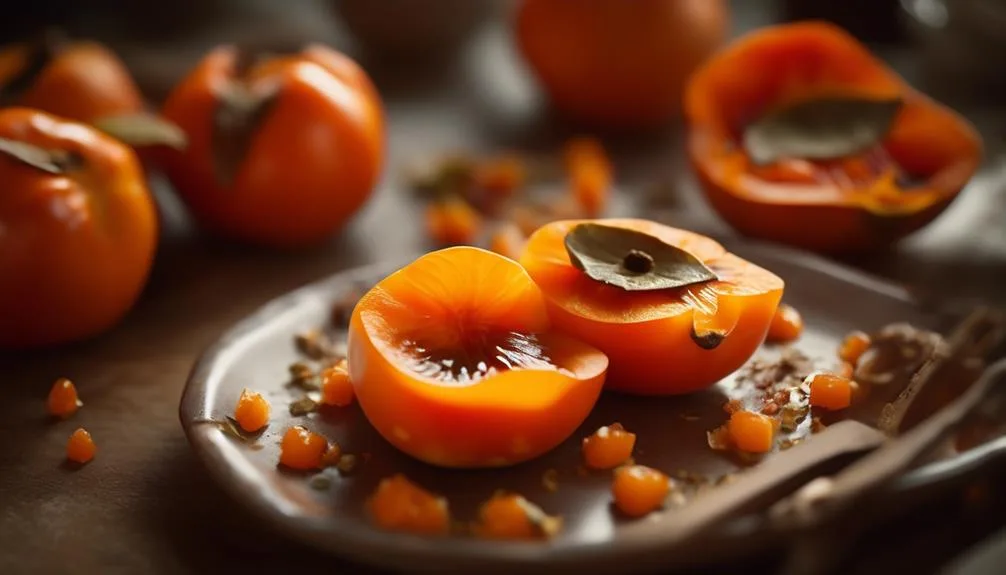The sweet and vibrant persimmon fruit is a key ingredient in traditional dishes from around the world. Its honey-like flavor adds a special touch to Asian desserts and Mediterranean meals.
Exploring how different cultures use persimmons in their cuisine is a fascinating way to expand your culinary knowledge. Whether you're a cooking enthusiast or just love trying new foods, the role of persimmons in traditional dishes is definitely worth discovering.
Key Takeaways
- Persimmons are prized for their sweet, honey-like flavor and are used in a variety of dishes in Asian, Mediterranean, South American, European, and North American cuisines.
- In Asian cuisine, persimmons are used as a palate-cleansing sorbet and a garnish for sashimi, while dried persimmons are enjoyed as a traditional sweet treat.
- In Mediterranean cuisine, persimmons are used in salads, chutneys, and as a condiment for grilled meats and hearty stews.
- In South American cooking, persimmons add natural sweetness to both savory dishes and desserts, and are a cherished component of traditional recipes.
- In European culinary traditions, persimmons are utilized in an array of delicious recipes, including desserts, savory dishes, and condiments.
- In North American gastronomy, persimmons are incorporated into a wide range of recipes, such as pudding, bread, and salsa, and are valued for their health benefits.
Persimmon in Traditional Asian Cuisine
In traditional Asian cuisine, persimmons are prized for their sweet, honey-like flavor and are commonly used in a variety of dishes, adding a delightful touch to both savory and sweet recipes.
In Japanese kaiseki, the elegant multi-course meal, persimmons often make an appearance as a palate-cleansing sorbet or as a garnish for sashimi due to their refreshing taste and vibrant color. The Japanese also use dried persimmons, known as hoshigaki, as a traditional sweet treat.
In Chinese dim sum, persimmons are incorporated into desserts such as steamed persimmon cakes, known for their luscious texture and subtle sweetness.
The versatility of persimmons in Asian cuisine is evident, as they effortlessly transition from being a palate cleanser in kaiseki to a star ingredient in dim sum desserts.
Persimmon in Mediterranean Dishes
Mediterranean cuisine beautifully incorporates the sweet and vibrant flavors of persimmons into a variety of traditional dishes, adding a unique and delightful touch to the region's culinary offerings.
One popular dish is the Mediterranean persimmon salad, which combines the juicy sweetness of ripe persimmons with crisp greens, tangy feta cheese, and a light vinaigrette, creating a refreshing and flavorful salad that perfectly complements the region's sunny and relaxed atmosphere.
Additionally, persimmons are also used to make a delicious persimmon chutney. This versatile condiment features a perfect balance of sweetness and tanginess, and it pairs wonderfully with a variety of Mediterranean dishes, from grilled meats to hearty stews.
The addition of persimmons to Mediterranean cuisine truly showcases the fruit's versatility and ability to elevate traditional dishes with its distinctive flavor profile.
Persimmon in South American Cooking
South American cooking beautifully incorporates the luscious and sweet flavors of persimmons into a wide array of traditional dishes, infusing them with a delightful and unique taste.
When it comes to persimmons in South American cuisine, you'll find that they're used in a variety of indigenous recipes, adding a burst of natural sweetness to savory dishes and desserts. Some traditional South American recipes feature persimmons as a key ingredient, showcasing the fruit's versatility and ability to complement different flavor profiles.
Additionally, South American fusion cuisine has also embraced persimmons, blending their sweetness with local ingredients to create innovative and exciting dishes that combine traditional flavors with modern culinary techniques.
Whether it's a classic indigenous recipe or a contemporary fusion creation, persimmons are a cherished component of South American cooking.
Persimmon in European Culinary Traditions
European culinary traditions have long embraced the unique flavors and versatility of persimmons. Incorporating them into a wide range of traditional dishes that showcase the fruit's natural sweetness and ability to complement various flavor profiles.
In European cuisine, persimmons are utilized in an array of delicious recipes. From the classic French persimmon tart to Italian persimmon pudding, the fruit is a staple in many European desserts.
Additionally, in Spain, persimmons are often enjoyed in savory dishes. Such as salads or paired with cured meats and cheeses.
In Eastern Europe, particularly in countries like Romania and Hungary, persimmons are used in jams, chutneys, and even as a glaze for meats.
The versatility of persimmons in European culinary traditions truly shines through in the wide variety of both sweet and savory dishes that feature this delectable fruit.
Persimmon in North American Gastronomy
Indulge in the luscious flavors and versatility of persimmons as you explore their role in North American gastronomy. In North American cuisine, persimmons are cherished for their unique taste and are incorporated into a wide range of recipes such as persimmon pudding, persimmon bread, and persimmon salsa. These dishes showcase the fruit's ability to add a delicious sweetness and depth of flavor.
Moreover, persimmons are valued not only for their taste but also for their health benefits. Packed with nutrients and antioxidants, they contribute to improved digestion, heart health, and immune function, making them an excellent addition to a balanced diet.
Conclusion
Incorporate persimmon fruit into your traditional dishes for a unique and delightful twist.
Whether you're cooking in Asia, Europe, South America, North America, or the Mediterranean, persimmons can enhance your culinary traditions with their sweet and tangy flavor.
Embrace the versatility of persimmons and elevate your dishes to new heights with this exciting addition to your cooking repertoire.

